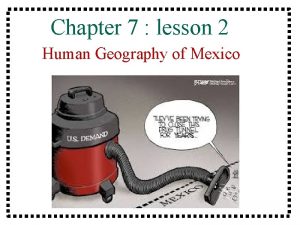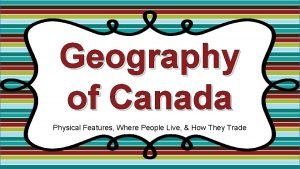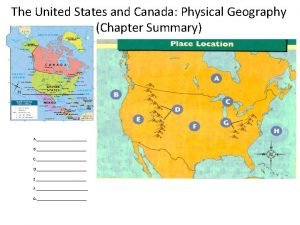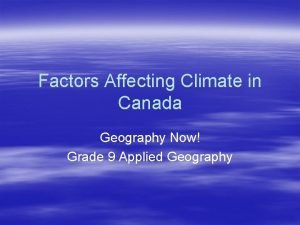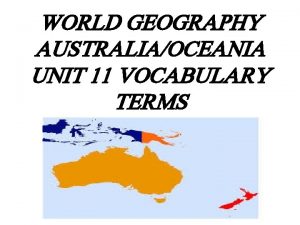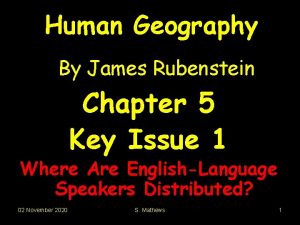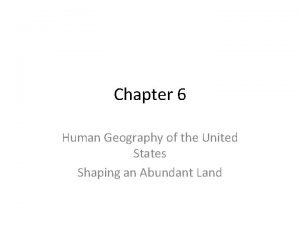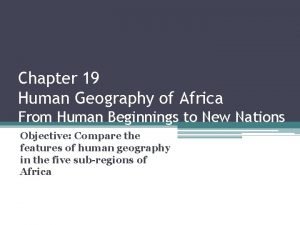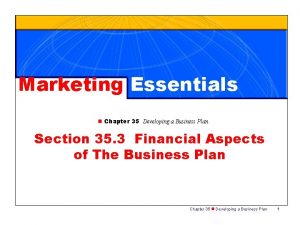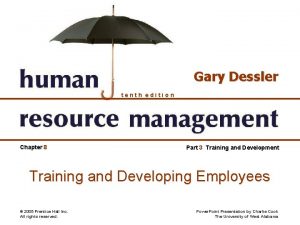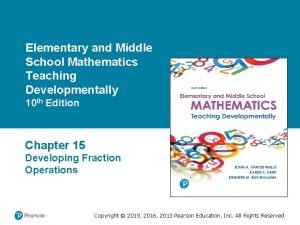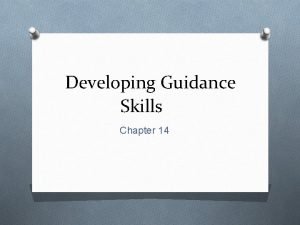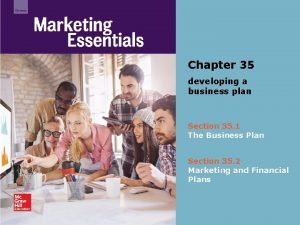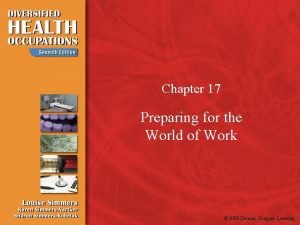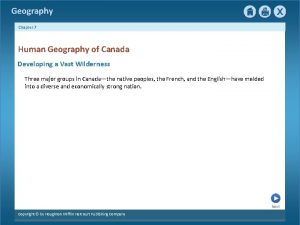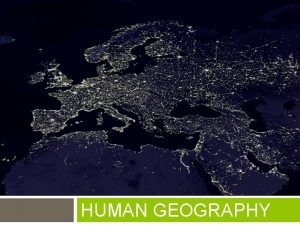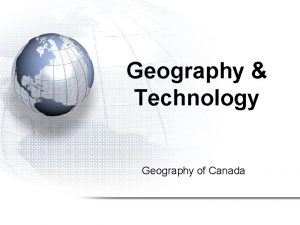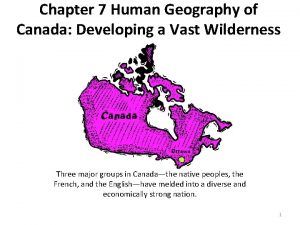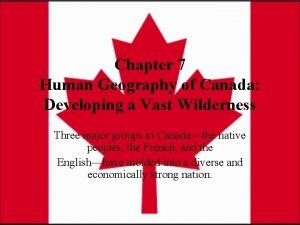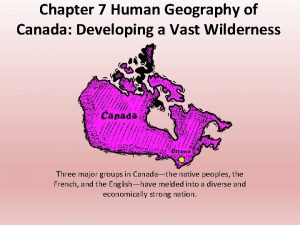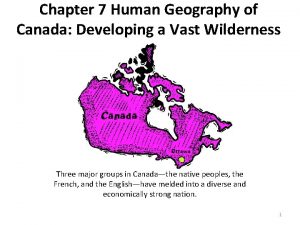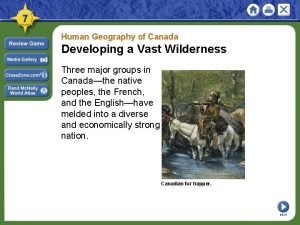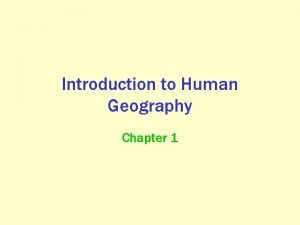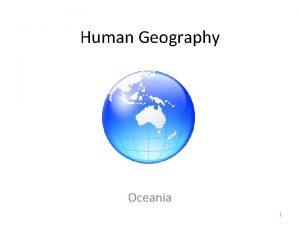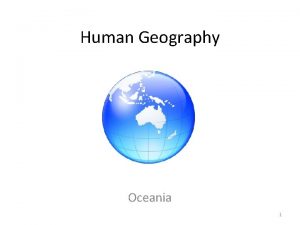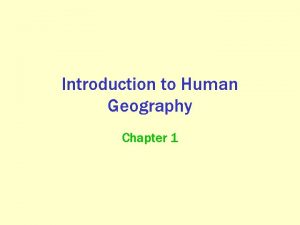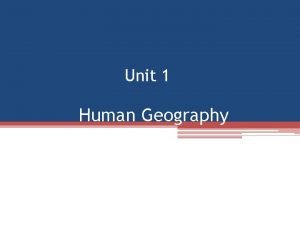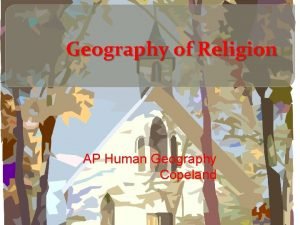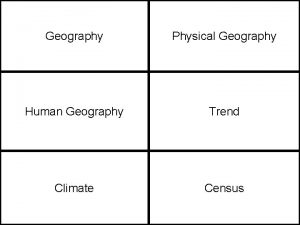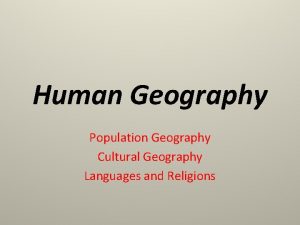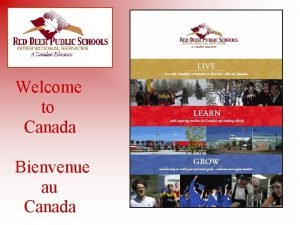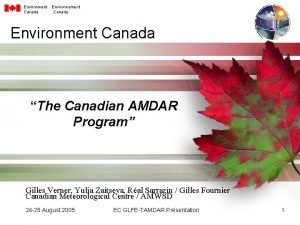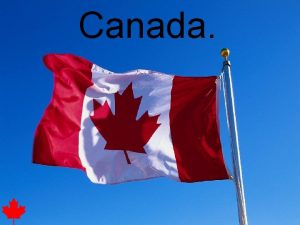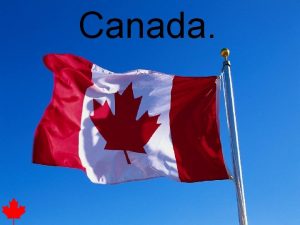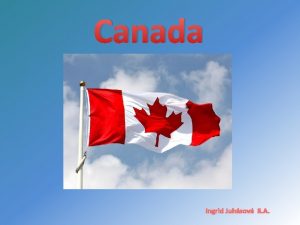Human Geography of Canada Chapter 7 Developing a


























- Slides: 26

Human Geography of Canada Chapter 7 Developing a Vast Wilderness

Early Peoples l Vast size & cold climate affected development l 1 st settlers came from Asia across the land bridge l Ancestors of the Inuit & Native American Indians

Early Peoples About A. D. 1000, Leif Erikson landed in what is now Newfoundland l Called it Vinland, after the wild grapes there l Vikings built a settlement & later and later abandoned it l

Early Peoples In 1497, Giovanni Caboto (John Cabot in English) an Italian navigator, landed in Newfoundland & claimed the region for England l European exploration & colonization followed l

France & Britain l In the 16 th & 17 th century, French explorers claimed much of Canada l Settlements were called New France l British colonized the Atlantic coast l Fisheries & inland fur trade were important to both

French & British Challenged Claims l British defeated the French in the French & Indian War (1754 -1763) l Forced France to surrender its territory, but French settlers remained

Steps Toward Unity l l l In the 18 th century, there were 2 distinct cultures Roman Catholic French & Protestant English Conflict erupted In 1791, the British government split Canada into 2 provinces Upper Canada (Ontario) – English speaking majority Lower Canada (Quebec) – French speaking majority


Dominion of Canada l In 1867, created the Dominion of Canada l Loose confederation of Ontario, Quebec, 2 British colonies (Nova Scotia & New Brunswick) l Remained part of the British Empire, but had self-government l Ottawa, Ontario became the capital

Canada’s Government Today Recognized by the British as an independent nation in 1931 l Parliamentary government, system in which legislative & executive functions are combined in the legislature called a parliament l Parliament consists of an appointed Senate & an elected House of Commons l The majority party’s leader in Parliament becomes Prime Minister l

Parliament

Economy l Industries: l l l l l Farming Logging Mining Fishing Automobiles Steel Household appliances Electronics High-tech and mining equipment

Economy l 60% of the GDP comes from service industries l Tourism, communications, finance, utilities, etc. l NAFTA – North American Free Trade Agreement l Made trade between Mexico, U. S. , & Canada easier

Language l Officially a bilingual country l English-speaking majority l French-speaking minority l Native languages

Religion l Protestant (English) l Roman Catholic (French) l Muslims l Jews

Population l 33 million l 80% of Canadians live on 10% of the land l Most live along a 100 mile strip of land just north of the U. S. border

Life in Canada Today l Leisure time Skating, ice hockey, fishing, skiing, golf, & hunting l Professional sports teams (own football league and ice hockey, baseball, basketball teams compete in U. S. leagues) l


Subregions of Canada l Atlantic Provinces Prince Edward Island, New Brunswick, Nova Scotia, & Newfoundland l 8% of the population l Most live on coastal cities l Small population due to rugged terrain & severe weather l

Nova Scotia

Subregions of Canada l The Core Provinces Quebec & Ontario l Canada’s heartland l 3 out of 5 Canadians live there l Settlement along the Great Lakes and St. Lawrence Seaway l Political & economic life l

Ottawa

Subregions of Canada l The Prairie Provinces Manitoba, Saskatchewan, & Alberta l Canada’s breadbasket l 50% of Canada’s agricultural production l


Subregions of Canada l British Columbia & the Territories Yukon Territory, Northwest Territories, & Nunavut l Vancouver, BC is Canada’s largest port l Territories make up 41% of the land mass l

Vancouver
 What influenced mexico’s political and social structures
What influenced mexico’s political and social structures Ap human geography frq format
Ap human geography frq format 5 themes of geography ap human geography
5 themes of geography ap human geography Stateless nation
Stateless nation Gni definition ap human geography
Gni definition ap human geography Canada's physical geography
Canada's physical geography Slidetodoc.com
Slidetodoc.com Geography now canada
Geography now canada Ap human geography chapter 11 vocab
Ap human geography chapter 11 vocab Chapter 16 section 1 russia and the western republics
Chapter 16 section 1 russia and the western republics Chapter 22 human geography of southwest asia
Chapter 22 human geography of southwest asia Chapter 11 ap human geography
Chapter 11 ap human geography Dialect human geography
Dialect human geography Chapter 13 human geography of europe
Chapter 13 human geography of europe Received pronunciation definition ap human geography
Received pronunciation definition ap human geography Why is the united states called a postindustrial economy
Why is the united states called a postindustrial economy Chapter 25 human geography of south asia
Chapter 25 human geography of south asia Chapter 19 human geography of africa
Chapter 19 human geography of africa 8.3 human needs
8.3 human needs Chapter 8 human needs and human development
Chapter 8 human needs and human development Chapter 35 developing a business plan
Chapter 35 developing a business plan Chapter 8 training and developing employees
Chapter 8 training and developing employees Chapter 15 developing fraction concepts
Chapter 15 developing fraction concepts Developing guidance skills chapter 14 worksheet answers
Developing guidance skills chapter 14 worksheet answers Chapter 35 developing a business plan
Chapter 35 developing a business plan The marketing plan the central instrument
The marketing plan the central instrument Chapter 18 preparing for the world of work
Chapter 18 preparing for the world of work
